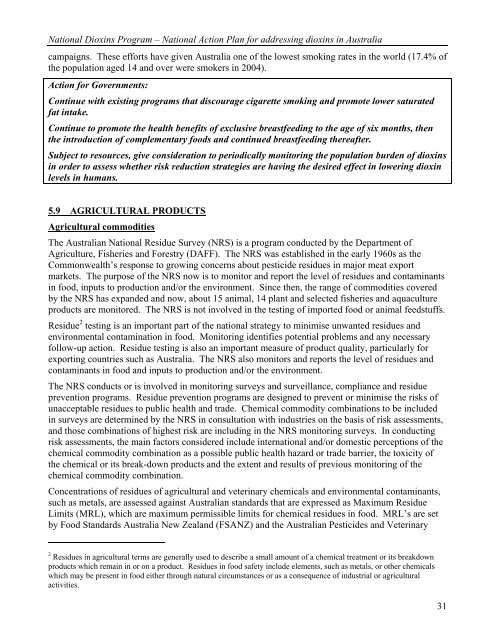National Action Plan for Addressing Dioxins in Australia
National Action Plan for Addressing Dioxins in Australia
National Action Plan for Addressing Dioxins in Australia
- No tags were found...
Create successful ePaper yourself
Turn your PDF publications into a flip-book with our unique Google optimized e-Paper software.
<strong>National</strong> <strong>Diox<strong>in</strong>s</strong> Program – <strong>National</strong> <strong>Action</strong> <strong>Plan</strong> <strong>for</strong> address<strong>in</strong>g diox<strong>in</strong>s <strong>in</strong> <strong>Australia</strong>campaigns. These ef<strong>for</strong>ts have given <strong>Australia</strong> one of the lowest smok<strong>in</strong>g rates <strong>in</strong> the world (17.4% ofthe population aged 14 and over were smokers <strong>in</strong> 2004).<strong>Action</strong> <strong>for</strong> Governments:Cont<strong>in</strong>ue with exist<strong>in</strong>g programs that discourage cigarette smok<strong>in</strong>g and promote lower saturatedfat <strong>in</strong>take.Cont<strong>in</strong>ue to promote the health benefits of exclusive breastfeed<strong>in</strong>g to the age of six months, thenthe <strong>in</strong>troduction of complementary foods and cont<strong>in</strong>ued breastfeed<strong>in</strong>g thereafter.Subject to resources, give consideration to periodically monitor<strong>in</strong>g the population burden of diox<strong>in</strong>s<strong>in</strong> order to assess whether risk reduction strategies are hav<strong>in</strong>g the desired effect <strong>in</strong> lower<strong>in</strong>g diox<strong>in</strong>levels <strong>in</strong> humans.5.9 AGRICULTURAL PRODUCTSAgricultural commoditiesThe <strong>Australia</strong>n <strong>National</strong> Residue Survey (NRS) is a program conducted by the Department ofAgriculture, Fisheries and Forestry (DAFF). The NRS was established <strong>in</strong> the early 1960s as theCommonwealth’s response to grow<strong>in</strong>g concerns about pesticide residues <strong>in</strong> major meat exportmarkets. The purpose of the NRS now is to monitor and report the level of residues and contam<strong>in</strong>ants<strong>in</strong> food, <strong>in</strong>puts to production and/or the environment. S<strong>in</strong>ce then, the range of commodities coveredby the NRS has expanded and now, about 15 animal, 14 plant and selected fisheries and aquacultureproducts are monitored. The NRS is not <strong>in</strong>volved <strong>in</strong> the test<strong>in</strong>g of imported food or animal feedstuffs.Residue 2 test<strong>in</strong>g is an important part of the national strategy to m<strong>in</strong>imise unwanted residues andenvironmental contam<strong>in</strong>ation <strong>in</strong> food. Monitor<strong>in</strong>g identifies potential problems and any necessaryfollow-up action. Residue test<strong>in</strong>g is also an important measure of product quality, particularly <strong>for</strong>export<strong>in</strong>g countries such as <strong>Australia</strong>. The NRS also monitors and reports the level of residues andcontam<strong>in</strong>ants <strong>in</strong> food and <strong>in</strong>puts to production and/or the environment.The NRS conducts or is <strong>in</strong>volved <strong>in</strong> monitor<strong>in</strong>g surveys and surveillance, compliance and residueprevention programs. Residue prevention programs are designed to prevent or m<strong>in</strong>imise the risks ofunacceptable residues to public health and trade. Chemical commodity comb<strong>in</strong>ations to be <strong>in</strong>cluded<strong>in</strong> surveys are determ<strong>in</strong>ed by the NRS <strong>in</strong> consultation with <strong>in</strong>dustries on the basis of risk assessments,and those comb<strong>in</strong>ations of highest risk are <strong>in</strong>clud<strong>in</strong>g <strong>in</strong> the NRS monitor<strong>in</strong>g surveys. In conduct<strong>in</strong>grisk assessments, the ma<strong>in</strong> factors considered <strong>in</strong>clude <strong>in</strong>ternational and/or domestic perceptions of thechemical commodity comb<strong>in</strong>ation as a possible public health hazard or trade barrier, the toxicity ofthe chemical or its break-down products and the extent and results of previous monitor<strong>in</strong>g of thechemical commodity comb<strong>in</strong>ation.Concentrations of residues of agricultural and veter<strong>in</strong>ary chemicals and environmental contam<strong>in</strong>ants,such as metals, are assessed aga<strong>in</strong>st <strong>Australia</strong>n standards that are expressed as Maximum ResidueLimits (MRL), which are maximum permissible limits <strong>for</strong> chemical residues <strong>in</strong> food. MRL’s are setby Food Standards <strong>Australia</strong> New Zealand (FSANZ) and the <strong>Australia</strong>n Pesticides and Veter<strong>in</strong>ary2 Residues <strong>in</strong> agricultural terms are generally used to describe a small amount of a chemical treatment or its breakdownproducts which rema<strong>in</strong> <strong>in</strong> or on a product. Residues <strong>in</strong> food safety <strong>in</strong>clude elements, such as metals, or other chemicalswhich may be present <strong>in</strong> food either through natural circumstances or as a consequence of <strong>in</strong>dustrial or agriculturalactivities.31
















